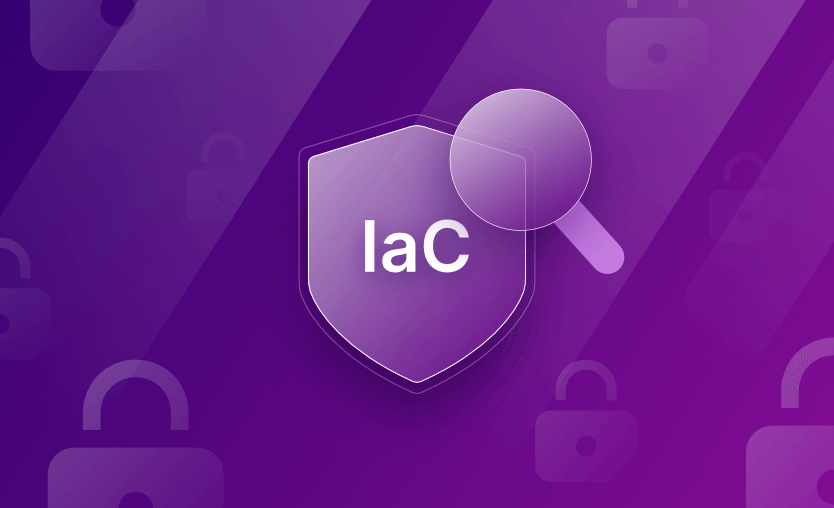IaC Security Scanning: Ensuring Security in the Open-Source Environment

IaC, or infrastructure as code, is essential to most cloud-based applications. Implementing IaC has advantages that significantly increase the service's characteristics and efficiency. However, as well as its enormous value, IaC has certain security drawbacks, like the spreading of simple security issues on all the files or vulnerability to data exposure, which could greatly affect the security of an open-source environment.
The good news is that these drawbacks can be equalized by IaC security scanning. This article will examine the importance of IaC security and explain how IAC security scanning can help secure your open-source environment.
What Is Infrastructure as Code (IAC) & Why Is It Beneficial?
Infrastructure as code is the practice of managing software infrastructure with the help of code and automation tools. So instead of manual resource configuration, IaC enables process optimization by setting the system's desired state and how the resources should be configured.
To manage software infrastructure, engineers dedicate a huge amount of time. And with the growth of cloud computing, revising infrastructure components would take too many resources. However, thanks to IaC, organizing IT infrastructure can be less costly, free of human errors, and less time-consuming.
What Are the Main Security Risks & Drawbacks of Implementing IAC?
Along with the beneficial value, IaC security scanning comes with its drawbacks that are essential to be aware of when following this approach.
Template Misconfiguration
Template configuration is the main concern that bothers engineers using IaC security scanning methods. For example, suppose there is a missing symbol in a code, which becomes inaccurate for the whole infrastructure. Or if a template contains unintentionally sensitive data. Hackers having access to it can manipulate the infrastructure.
Data Exposure
Managing sensitive information becomes another concern in infrastructure as code approaches. When creating cloud storage, engineers must ensure a secure environment for the stored data. For example, enable data encryption and usage of secrets manager.
What Is IaC Security Scanning?
Infrastructure as code security scanning is a special process that involves checking and evaluating possible weaknesses and vulnerabilities that may lead to security threats. The key feature of the IaC security scanning is that it doesn’t represent the IaC system itself.
Instead, it focuses on ensuring safe and efficient processes that will not affect the security of the revised cloud resources. It can be imagined as a special method constructed only to keep the normal security levels inside the IaC. For that matter, IaC security scanning resorts to inputting the security elements into the IaC protocols and scripts.
Who Needs an IaC Security Scanning?
The IaC security scanning method is crucial for any service, platform, or piece of software due to the high probability of possible data leaks or malicious attacks. However, it doesn’t decrease the usage of IaC tools by software giants such as Linux or Windows. To prevent undesirable consequences, mostly open-source Linux implements the necessary IaC security components to decrease such threats to zero.
The Importance of IaC Security Scanning for Open-Source Environments
The value of security scanning must be maintained since its effectiveness is directly related to the whole array of cloud folders. Even one hazardous file may lead to significant security leaks that may cause serious damage to the entire cloud environment database.
For example, in 2023 alone, the average data breach in the U.S. cost around 9.48 million dollars. However, besides the obvious financial reasons, we have collected other facts that show the importance of IaC security.
Solving the Service Vulnerabilities
The importance of the IaC security implementation lies in preventing possible vulnerabilities and solving existing ones. With the help of the leading IaC security scanners, the DevOps team gains an excellent opportunity to avoid even the slightest opportunities for data leaks or hostile cyber-attacks. The IaC's solutions ensure that the necessary security requirements are correctly implemented into the project in the early stages.
Increasing the Software Efficiency
Another significant issue that can be solved by the forehanded security check is the increase in software optimization. By implementing IaC security testing, the team and the testers can find more efficient solutions for the existing problems. That is connected to the fact that the whole system is verifiable during the scanning. Such an approach regularly leads to considering the issue from a different angle and the occurrence of unexpected solutions.
Improving the Analysis and Environment Management
Centralization in data security also leads to a better understanding of the business processes inside your environment. An order inside thousands of cloud files, structured according to the appropriate schedule, will bring a clear vision and make the management of the structure more accessible. As a result, following analytic events and tests will become more efficient and convenient.
What Are the Main Stages in IaC Security Scanning?
There are six main stages of the structure and subsequence of IaC scanning. Each stage represents an integral part of the scanning process. Let’s look at each of them in the section below.
Initialization
The first stage in the IaC scanning of your software service will be the initialization. During this step, you must set specific requirements that your scanning will adhere to. This is a crucial stage since the basics of all outgoing checks and scanning will be pledged during the initialization. Thus, it’s necessary to prepare your documentation as best as possible.
Integration
During the integration stage, the team will ensure the IaC scanning is well integrated inside the system and into the CI/CD pipelines. This action allows checking if the IaC scans are well synchronized even during the runs through the pipelines. It helps to ensure the continuing process of the IaC scanning.
Execution
When going through the execution process, the team ensures the IaC scanning fits the predefined requirements set during initialization. During execution, checking the sync accuracy between the scan and requirements is essential to prevent misconfigurations.
Review
Review, also known as the post-scan stage, is when the received results are carefully reviewed to assume the following actions. Usually, during the review, each finding is carefully analyzed to develop possible solutions for proper system operation.
Remediation
The remediation stage includes implementing specific actions to solve the detected contravention during the IaC scanning. As a result, it has to be completed by integrating certain changes into the current IaC scripts and modifying them according to the possible solution.
Feedback Loop
A feedback loop is the final but not the last step during the process of IaC scanning. The fact is that this process is required for the continuation of the process. However, it’s aimed at collecting feedback with the further goal of improving subsequent tests and scans.
What Are the Main Components of the IaC Security Scanners?
 A security scanner evaluates and checks security levels in open-sourced environments. The structure of such components remains the same for most SaaS platforms. Typically, most such scanners consist of the basic components listed below.
A security scanner evaluates and checks security levels in open-sourced environments. The structure of such components remains the same for most SaaS platforms. Typically, most such scanners consist of the basic components listed below.
- Scanning engine. The main part of the security scanner remains the scanning engine. This component is the one that takes a part of the IaC files and compares it to a specific standard. The scanning engine implies checking your IaC files before employment in the cloud-based environment, preventing security threats.
- Library of standards. The library regularly consists of several files that contain regulations, tasks, standards, and requirements. All these files are needed to ensure the IaC files meet the required indicators.
- Module of reports. This component represents the documentation with the received data that will help analyze the results of the IaC security scan. A properly created module report can highlight the current misconfigurations and provide information about possible ones.
- CI/CD frameworks. The IaC scanning during the CI/CD pipelines implies some key factors. For example, this approach suggests removing all credentials and ensuring adoptive permissions to prevent data leaks.
Final Thoughts on the Importance of IAC Security Scanning
IaC security scanning is an integral component in any software or application development. It’s required to consider the following properly:
- Data-Based Risk Assessment: This is crucial in today's environment, where data breaches can have significant financial and reputational consequences.
- Integration with CI/CD Pipelines: This ensures that security checks are performed automatically and consistently.
- Enhanced System Development: Regular security scanning helps in maintaining the integrity of the system development process.
- Efficiency and Convenience for DevOps Teams: This leads to more efficient workflows, as security issues can be identified and addressed quickly and easily.
- Creation of Secure Products: This is crucial in building trust with users and clients, especially in an era where cyber threats are increasingly sophisticated and common.
IaC security scanning is fundamental to creating robust, secure, and reliable software.





















